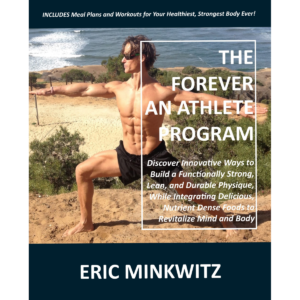Strength and Conditioning for the Downhill Skier (Part 2)
When I am training downhill skiers, I make sure to address the following components to ensure a successful and fun ski season:
Strength: Renowned sports physiologist Steven Plisk describes how elite downhill skiers have “exceptional strength in the extensors of the foot, leg, thigh, and trunk” (1). These skiers also tend to be mesomorphs with dense, powerful muscles and bones, as opposed to long and lean builds. In order to build a base of strength, you should choose the following core lifts, done with impeccable form:
- Squats / Front Squats
- Push Press
- Bench Press
- Bent Over Rows
- Pull Ups
- Physioball Abdominal Crunches and Planks: important for core muscular development
- Supine Hamstring Curls on Physioball: a vital move for developing ham, hip, and lower back musculature
- Romanian Deadlifts
- Single Leg RDLs with external rotations
Flexibility: Olympic downhill skiing fans will recall Austrian Hermann Meier’s spectacular crash in the 1998 Olympic Games. Despite a 3.5 second free fall, he came away virtually unscathed, due in part to his tremendous total body strength and flexibility. Flexibility, especially through the hip complex, hamstrings, and lower back, are vital for avoiding injury on the slopes and for enhancing recovery. This can be developed through a combination of dynamic stretches, yoga, and Pilates. Save static stretches for when the body has been properly warmed up and muscles and tendons are more pliable.
Aerobic Capacity: Whether you normally ski long blue cruisers or short and steep double blacks, an aerobic base is crucial for any skier. Cross-training with stair climbers, swimming, grass or sand interval sprints, cycling, etc. will help develop this and reduce repetitive overuse stress on your joints.
Power and Anaerobic Capacity: Alpine skiing is a power sport, period. Tremendous forces must be reproduced throughout the calves, quads, hamstrings, hips, abdominals, and erector spinae groups. In order to generate these specialized motor unit recruitment patterns, sports physiologist Steven Plisk emphasizes that a base of strength, flexibility, and aerobic conditioning must be established (1) prior to integrating power training into your program. The power program can also include the athlete’s metabolic conditioning, which involves improving one’s anaerobic capacity. This is obtained when jumping intensity is high and the exercise time corresponds to your average ski run (1.5 – 3 minutes). Power training will include plyometrics and Olympic lifting variations:
1. Jumps:
- Plyometrics: box jumps performed in linear fashion, and with 180 degree torso rotations
- Lateral box jumps: maintain flexion through the hips in order to cushion landing
- Single leg hops lateral and angular hops
2. Olympic and Explosive Lifting:
- Push jerks: performed with 25% of your 1RM for squats, perform a ¾ back squat and then forcefully drive the bar overhead.
- Power cleans: deadlifting the bar past the knees, and then forcefully driving the hips and shoulders upward to hoist the bar to the lower chest. When the bar reaches mid-torso, sink under the bar in a front squat position, driving the elbows forward, and keeping the lumbar spine in a neutral position and knees over the mid-foot.
- Power variations: shrug pulls, jump shrugs, hang snatches, etc.
- Explosive squat jumps with dumbbells
Dynamic Balance and Injury Prevention: Dynamic balance has utility in preparing athletes for a wide range of sports because it acts as an injury preventative measure. Dynamic balance exercises train ankle, knee, and hip joint stability, proprioception, and joint responsiveness. These skills are obtained through establishing the skier’s hip and knee angles, and then maintaining these angles while balancing on one foot. To increase training difficulty, the skier can stand on an unsteady surface, such as a pillow, and throw a medicine ball with a partner or against a wall, without changing optimal ankle, knee, and hip angles.
Quickness and Agility: According to strength and conditioning coach Jamie Hale, these skills train the nervous system to “improve the instantaneous recruitment of a maximal number of motor units (MU), improve the firing rate of MU, and increase intermuscular coordination” (4). Quickness and agility is developed by playing sports that emphasize lateral changes in direction, such as basketball and tennis. Sprint training, shuttle runs, cone drills, and other drills that require quick, lateral and angular bursts are also good for the downhill skier.
Conclusion: Skiing is an exhilarating sport that challenges the body’s musculoskeletal, cardiovascular, and metabolic systems. A skier is prone to injury late in the day when he/she is fatigued, and/or has neglected his off-season physical preparation. By targeting the above ski-related skills, you will increase performance and enjoyment, while reducing injury risk factors.
Bibliography:
- Plisk, S. National Strength and Conditioning Journal, Vol 10, No 1, 1988.
- Karlsson, Erickson, et al. The Physiology of Alpine Skiing. US Coaches Association. Park City, UT. 1989
- Viola, Steadman, et al. Anterior Cruciate Ligament Injury Incidence among Male and Female Professional Alpine Skiers. The American Journal of Sports Medicine 27:792-795 (1999).
- Hale, J. Quickness Training. Bodybuilding.com.




This is a well done article that I have bookmarked for future reference. Have a great day.
Thanks for your great feedback!